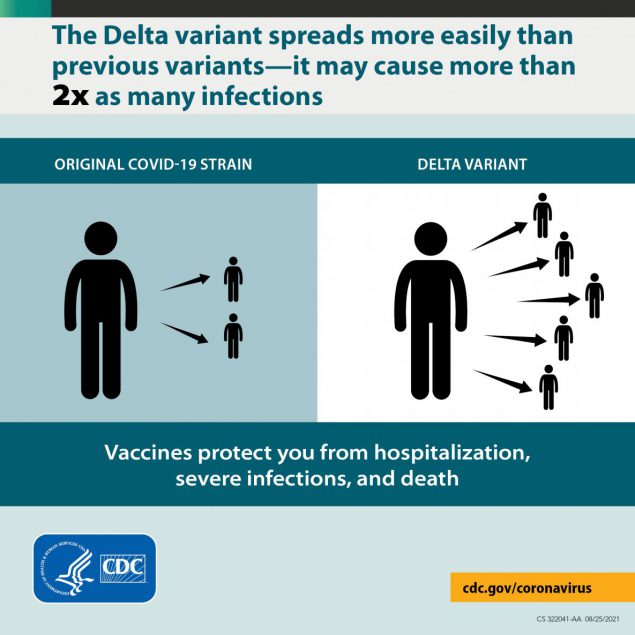The New COVID Strains: Delta, Lambda, and Mu Variants
Hello Mayfield! We have officially returned to school and I know that we are all excited to be back. However, we cannot forget that we must follow the COVID guidelines that the school has in place. There are three new variants of COVID – Delta, Lambda, and Mu – and they are more contagious than ever.
The COVID-19 vaccines approved and authorized by the FDA have been effective in preventing severe hospitalization and death, but it is important to remember they will not prevent one from contracting COVID. Low vaccination coverage, especially in crowded communities, drives the rapid spread of virus, increasing the chances of a possible viral mutation; moreover, creating a new variant.
The Delta Variant
The Delta variant, also known as the B.1.617 lineage, is two times more infectious than past variants and leads to an increased transmissibility with other variants, even when vaccinated. The greatest risk of transmission is among the unvaccinated, as they are more likely to transmit and spread the virus. In studies with people who have had the Delta variant, there was a similar amount of viral genetic material found in vaccinated and unvaccinated people. However, it has been found that the viral genetic material drastically decreases quicker in the vaccinated individuals in comparison to the unvaccinated; thus, they are likely to spread the virus for a shorter period of time.
According to CDC data, it has shown that the Delta Variant accounts for 99% of the COVID cases today. The mutation that the Delta Variant has allows the virus to attach to our cell receptors in our airways.
Lambda Variant
The Lambda Variant, the C.37 variant, was classified by the World Health Organization (WHO) as early in August 2020. WHO has considered that the Lambda straight has multiple mutations with established implications for its transmissibility and severity. In recent months, the Lambda strain has become dominant in Argentina, Chile, and Colombia. Although it has been identified in the United States, the strain has yet to populate.
The Lambda variant differs by 23 nucleotide changes and 18 amino acid changes from the original SARS-CoV-2. 16 of the nucleotide mutations and 11 amino mutatiations live outside the S gene encodes for the spike protein. These effects may change the ability of Lambda to enhance their replication of the innate and adaptive immune responses, early in the infection.
“Any time a variant is identified and demonstrates the capacity to rapidly spread in a population, you have to be concerned,” Dr. Gregory Poland of the Vaccine Research Group at Mayo clinic noted.
Mu Variant
B.1621, also known as the Mu Variant, was discovered in Columbia in January 2021. The variant has been identified in all 50 states, with a total of more than 2,000 cases nationwide. Although the number is daunting, it only accounts for 0.02% of all the COVID infections in the country. Most of the cases have been recorded in wide population states, such as California, New York, and Texas. According to infectious disease expert Dr. Anthony Fauci, mu is not an “immediate threat right now,” but he suggests that the government should keep a close watch on the variant.
There has not been enough research regarding the Mu variant, and WHO has called for more research under the variant’s tramissbility and impact it has on our vaccination efficiency. The Public Health England has suggested that mu shares similar mutations with other variants that first originated in India.
Will the vaccine work against the New Variants?
No vaccine is 100% effective. While vaccines in the United States and Europe work effectively for earlier strains of COVID, it appears that the vaccine has a slightly less efficiency with the new variants.
The number of antibodies in fully vaccinated people is high enough that the virus cannot bind their spike protein to our cells, blocking the replication of the virus. Researchers have emphasized the importance of receiving two mRNA vaccines, as one shot is not effective enough to generate a minimal number of antibodies to defend against the virus. In addition, a second dose increases our B- cells, which churn out antibodies in defense, and T- cells, which find and destroy infected cells.
The FDA cleared a COVID-19 booster shot for those who are at a high risk of severe cases of COVID. As additional vaccines are authorized by the federal government, there will be an increasing number of people who have received further protection from the virus. Nationwide, the large number of people who remain unvaccinated, will continue to challenge the goal of reaching herd immunity and improving protection against the virus for the entire nation.

Heidi is a senior at Mayfield Senior School and is thrilled to be a part of Mayfield’s Crier, serving as the News Co-Editor in Chief and Assignment Manager....


